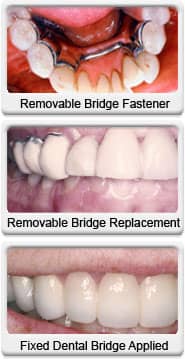Dental bridges are a popular and effective method of restoring your smile after losing one or more teeth. However, they are not invincible and may develop cracks over time, necessitating prompt attention. While the thought of a cracked bridge can be alarming, it’s crucial to remember that you’re not alone and that several options are available to get your smile back on track.

Image: www.smilesbypayet.com
In this article, we will accompany you on a journey exploring the ins and outs of repairing a cracked dental bridge. Learn about the different types of bridges, the common causes of cracking, and the various treatment options available. We’ll also provide you with expert advice and tips based on extensive research, ensuring that you’re well-informed every step of the way.
Understanding Dental Bridges and Their Significance
A dental bridge essentially serves as an artificial tooth that fills in the gap left by a missing tooth or teeth. They are often used in conjunction with dental crowns, which fit over and protect the teeth on either side of the gap, also known as the abutment teeth.
Before delving into the various causes of cracking in dental bridges, let’s familiarize ourselves with their types. There are three common types of bridges:
1. Traditional bridges:
They consist of an artificial tooth suspended between two dental crowns that fit over the abutment teeth.
2. Cantilever bridges:
These bridges involve a single dental crown attached to one abutment tooth and an extension that supports the artificial tooth.

Image: www.chandlerdentist.com
3. Maryland bonded bridges:
These bridges are commonly used when the abutment teeth are weak or have large fillings. They’re made of a metal framework that’s bonded to the backs of the abutment teeth, with an artificial tooth suspended in between.
Causes of Cracked Dental Bridges
Several factors can contribute to cracks developing in dental bridges, including:
1. Excessive biting forces:
Biting down on particularly hard foods, such as ice or nuts, can exert excessive pressure on the bridge, leading to cracks.
2. Bruxism (teeth grinding):
Grinding your teeth at night or clenching your jaw can also put excessive force on the bridge, potentially causing it to crack.
3. Poor oral hygiene:
Not practicing proper oral hygiene, including not brushing regularly or flossing, can lead to decay around the abutment teeth, thereby weakening the bridge’s support.
4. Wear and tear:
Over time, the materials used in dental bridges can weaken, making them more susceptible to cracking.
Repair Options for Cracked Dental Bridges
The repair approach for a cracked dental bridge will depend on various factors, including the severity and location of the crack. Here are some common treatment options:
1. Dental bonding:
This method may be appropriate if the crack is small and doesn’t extend too deeply into the bridge. Dental bonding involves applying a tooth-colored resin to the crack and hardening it with a curing light.
2. Crown replacement:
For larger cracks or those that affect the crown portion of the bridge, replacing the affected crown may be necessary. The dentist will remove the damaged crown and place a new one.
3. Bridge replacement:
If the crack is severe or if there’s significant damage to the abutment teeth, the entire bridge may need to be replaced.
Advice and Tips from Dental Experts
- Regular dental checkups are essential for early detection and prompt treatment of cracked dental bridges.
- Avoid chewing on excessively hard foods to minimize the risk of cracking.
- If you suffer from bruxism, consider wearing a nightguard to protect your bridge from excessive forces.
- Practice excellent oral hygiene to prevent decay around the abutment teeth
- Follow your dentist’s instructions carefully after bridge repair to ensure optimal healing.
FAQs on Cracked Dental Bridges
Q. What are the signs and symptoms of a cracked dental bridge?
. Sensitivity or pain when biting or chewing
. Visible cracks or chips in the bridge
Q. How long does it take to repair a cracked dental bridge?
. It depends on the severity of the crack and the chosen repair method. Minor repairs, such as dental bonding, can be completed in a single appointment, while more extensive repairs, like crown replacement, may require multiple appointments.
Q. Is it expensive to repair a cracked dental bridge?
. The cost of the repair will vary based on the extent of the damage and the type of treatment required.
Q. What are the potential risks associated with repairing a cracked dental bridge?
. Possible risks include further damage to the bridge, infection, and damage to the abutment teeth.
How To Fix A Cracked Dental Bridge
Conclusion
Dental bridges serve as valuable replacements for missing teeth, yet they can be susceptible.
Cracking. Understanding the various types of dental bridges, the common causes of cracking, and the available repair options is crucial for optimal outcomes. It is equally essential to prioritize oral hygiene and seek prompt dental attention if you suspect your bridge may be cracked to ensure quick repair and long-term dental health. Remember, a healthy smile is a happy smile!
Are you interested in learning more about how to fix a cracked dental bridge? Leave a comment below or ask your dentist for more information.